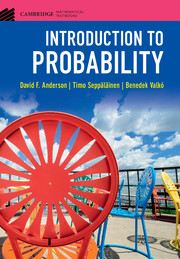Introduction to Probability
This classroom-tested textbook is an introduction to probability theory, with the right balance between mathematical precision, probabilistic intuition, and concrete applications. Introduction to Probability covers the material precisely, while avoiding excessive technical details. After introducing the basic vocabulary of randomness, including events, probabilities, and random variables, the text offers the reader a first glimpse of the major theorems of the subject: the law of large numbers and the central limit theorem. The important probability distributions are introduced organically as they arise from applications. The discrete and continuous sides of probability are treated together to emphasize their similarities. Intended for students with a calculus background, the text teaches not only the nuts and bolts of probability theory and how to solve specific problems, but also why the methods of solution work.
- Presented in full color and written in an accessible way, the text provides a comprehensive and well-balanced introduction to probability
- Pedagogical features include numerous examples to illustrate concepts and theory, over 600 exercises of varying levels, and separate 'Finer Points' sections for technical details
- An instructor's manual is available online with detailed solutions to selected problems and further guidance for using the book in a course
Reviews & endorsements
'The authors have carefully chosen a set of core topics, resisting the temptation to overload the reader. They tie it all together with a coherent philosophy. Knowing the authors' work, I would expect nothing less. I predict that this text will become the standard for beginning probability courses.' Carl Mueller, University of Rochester, New York
'This is an excellent book written by three active researchers in probability that combines both solid mathematics and the distinctive style of thinking needed for modeling random systems. It also has a great collection of problems. I expect it to become a standard textbook for undergraduate probability courses at least in the US.' Gregory F. Lawler, University of Chicago
'The content is beautifully set out, with clear diagrams … Definitions, theorems and key facts are highlighted. The precise natures of general ideas are carefully explained and motivated by diverse examples. Following each chapter, the reader is led gently into set exercises, with explicit signposts initially and more challenging problems at the end.' John Haigh, Significance
Product details
August 2018Adobe eBook Reader
9781108246705
0 pages
45 b/w illus. 48 colour illus. 600 exercises
This ISBN is for an eBook version which is distributed on our behalf by a third party.
Table of Contents
- 1. Experiments with random outcomes
- 2. Conditional probability and independence
- 3. Random variables
- 4. Approximations of the binomial distribution
- 5. Transforms and transformations
- 6. Joint distribution of random variables
- 7. Sums and symmetry
- 8. Expectation and variance in the multivariate setting
- 9. Tail bounds and limit theorems
- 10. Conditional distribution
- Appendix A. Things to know from calculus
- Appendix B. Set notation and operations
- Appendix C. Counting
- Appendix D. Sums, products and series
- Appendix E. Table of values for Φ(x)
- Appendix F. Table of common probability distributions.


